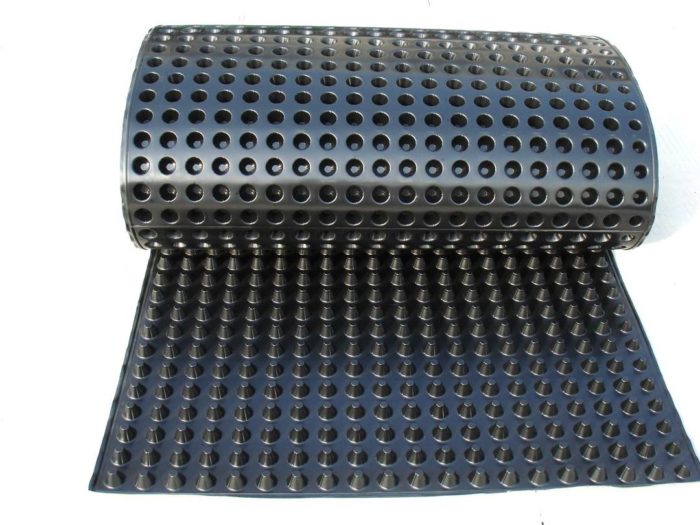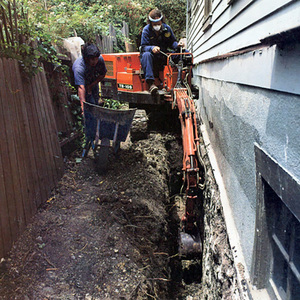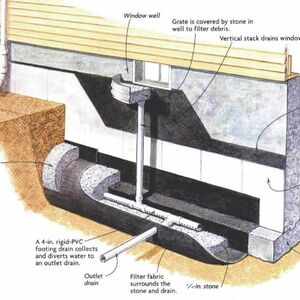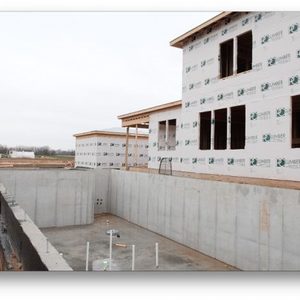
Image Credit: Image #1: DMX Plastics
Homeowners with problematic basements often post questions on GBA. They generally complain that their basements are damp, and that basement moisture problems aren’t easy to fix.
Solutions to damp basement problems are only indirectly connected to the topic of green building. In recent years, however, green builders — that is, builders who focus on energy efficiency — have become experts on moisture problems in buildings, in part because insulation problems are intimately tied to moisture problems.
In short, green builders are more likely to build a dry basement than a run-of-the-mill builders — and in this way, building a dry basement has become a green building concern.
One elegant and simple way to reduce the chance of moisture problems in basements is to install a dimple mat on the exterior side of the basement walls.
What is a dimple mat?
A dimple mat is a sheet of semi-rigid plastic (usually high-density polyethylene) that comes in a roll. The plastic has an egg-carton shape, with protruding dimples that make the membrane fairly thick — generally between 1/4 inch and 1/2 inch thick.
When a dimple mat is placed against a concrete wall, the dimples make the plastic stand out from the wall, leaving a free-draining air space between the plastic and the concrete. If any water reaches this air space, it easily flows to the bottom of the dimple mat.
It’s part of a system
While a dimple mat helps convey water to the bottom of a basement wall, it’s not enough to keep a basement dry. The dimple mat is intended to be part of a drainage system that includes a footing drain (see Image #2, below). Ideally, the footing drain system includes perforated 4-inch piping surrounded by crushed stone and a filter-fabric “burrito.” The footing drain needs to lead to daylight or a…
Weekly Newsletter
Get building science and energy efficiency advice, plus special offers, in your inbox.

This article is only available to GBA Prime Members
Sign up for a free trial and get instant access to this article as well as GBA’s complete library of premium articles and construction details.
Start Free TrialAlready a member? Log in















23 Comments
Probably Overkill
I'm building my cabin (zone 6b) using Faswall blocks, a hybrid ICF, and these blocks are designed to work without a vapor barrier. My current plan is to construct the foundation wall, apply a parge coat (probably with Quikrete surface bond cement), coat that with Thoroseal, then secure a SuperSeal dimple mat up to grade, then 3" of foam board or Roxul insulation before backfilling. I'll be using metal siding above grade. My hope is that any water vapor moving out of the foundation wall will be able to escape up or down through the dimple mat air space.
The perimeter drain will be constructed as outlined in Martin's article and with the drain line laid in with the septic drain and daylighting slightly beyond the tank location.
Response to David Williams
David,
Faswall blocks are made from 85% mineralized wood chips and 15% cement. While you note your hope that "any water vapor moving out of the foundation wall will be able to escape up or down through the dimple mat air space," your hope is unlikely to be realized.
Most foundations walls start out damp and stay that way forever. I assume that Faswall blocks are designed to handle moisture, especially if the manufacturer advises builders to use the blocks below grade. I advise you to get used to the idea that the below-grade wall will always be damp, with no need for drying in any direction.
Thanks for the reply, Martin.
Thanks for the reply, Martin. I guess I'm missing something. One of the supposed advantages of the Faswall block system is the ability of the block wall to serve not only as thermal mass but also as a "moisture sink" as well, providing a stable interior relative humidity as water vapor moves in, out, and through the block. Why would the foundation wall end up being any more or less damp than any other wall in the building interior?
Response to David Williams
David,
For an above-grade wall, the Faswall blocks are probably capable of acting as a moisture buffer. (I'm a skeptic, however, when it comes to the purported advantages of moisture buffering; for more information on this topic, see "Hygric Buffering and Hygric Redistribution.")
When it comes to a wall that is below grade, I don't think that the Faswall blocks will behave in the same way. A below-grade wall is always cool and damp -- because one side of the wall is always cool and damp. Try as you might to isolate the Faswall blocks from the outdoor environment -- with Thoroseal and dimple mat, for example -- the high humidity environment on the outside of the wall will influence the temperature and humidity levels of the Faswall blocks that are below grade.
But don't despair. The same can be said of a conventional concrete wall. If the interior and exterior of the wall are properly detailed, your basement will be dry and comfortable.
Thanks. Martin. I'm going to
Thanks. Martin. I'm going to relax a bit just knowing the environment I'm building in. I'm in south-central Montana at about 4400'. We get an average of about 14" of precipitation a year, the temps swing from -20+ to triple digits, and it's generally "drier than a popcorn fart" around here. Plus the "soil profile" at my location is about 6-10" of topsoil before moving into loosely consolidated, poorly sorted glacial till and sandstone/siltstone. Short of a biblical flood, I imagine I won't lose a lot of sleep over a wet basement. :)
This article leaves me with several questions.
The person from Dorken said that 90% of homes in the US only need damp-proofing while the remaining 10% actually need waterproofing. So which group do I belong to? If a basement excavation quickly turns into a swimming pool I'd say waterproofing is a good idea. I could go by recommendations of local builders, except that I've seen all too often that local practices aren't always correct practices. So how do I really now what level of water control to go to (without hiring a specialist)? Would knowing the soil type help? Ours is Brecknock BsB which is listed as a stony silt loam, well drained, which sounds favorable to me. (Brecknock is a township here in Lancaster Co, PA, climate zone 5).
My excavator thinks my excavation is dry enough that the sump pump may never turn on. We'll have engineered concrete walls (similar to Superior Walls) being poured in place in 2 days. The concrete outfit usually just sprays the walls with a damp-proofing sealant called Deco 20 and I'm told many people just backfill at that point. I'm wondering if I should do a little more and at least put in a dimple mat -- or will that be a waste of time and money?
Is there any way to fasten dimple mat other than fasteners that puncture the concrete. The concrete in engineered walls usually is 2.5 inches or less in thickness except at the "concrete studs" where it is maybe 8 inches. I'd rather not pound fasteners into the concrete, and it can be tricky to locate the concrete studs.
Lastly, are asphaltic based damp-proofers truly effective. I read one website (by a waterproofing outfit who has profit motive) and they said asphaltic degrades sometimes in less than 2 years due to the alkali nature of concrete. Is that true? And would it be OK to put a dimple mat against a wall with an asphaltic coating? I know that gasoline will dissolve styrofoam, so will an asphaltic material interact with a plastic dimple mat over the course of many years?
My last question (for now) -- is it necessary to install dimple mat up to grade? Hydrostatic pressure would be strongest the deeper you go so it makes sense at the footer. But will there be enough hydrostatic pressure at 4 feet below top of foundation to be an issue?
User 7430179,
First of all, can you tell us your name? (I'm Martin.)
Q. "The person from Dorken said that 90% of homes in the US only need damp-proofing while the remaining 10% actually need waterproofing. So which group do I belong to?... I could go by recommendations of local builders, except that I've seen all too often that local practices aren't always correct practices."
A. You can trust your builder, especially if your budget is tight. Or, if you plan to turn your basement into finished space, and your budget can handle the cost, you might decide that dimple mat is cheap insurance.
Q. "Is there any way to fasten dimple mat other than fasteners that puncture the concrete?"
A. You should follow the manufacturer's instructions. As far as I know, they all call for fastening the dimple mat in place -- but if the manufacturer allows, you might be able to get away with holding the dimple mat in place with the backfill.
Q. "Lastly, are asphaltic based damp-proofers truly effective?"
A. Not if you want a waterproof system.
Q. Is it necessary to install dimple mat up to grade?"
A. As far as I know, that's the usual installation method. Again, you should follow the manufacturer's installation instructions.
I am confused as to how the dimple board relieves hydrostatic pressure on the basement wall. Isn't it a waterproof, solid sheet of plastic? If so, how does the water find its way from the ground through the dimple board to the other side where it can freely drain down to the foundation drain? Unless the dimple board is somehow punctured or water finds its way through any lap joints, wouldn't the hydrostatic pressure of water in the ground simply build up on the soil side of the dimple mat, which would ultimately push against the basement wall?
The best dimple mats have a fabric scrim fastened to the outside. Water can get into the space between the scrim and the mat. The mat acts as the waterproofing layer. If water happens to find its way through holes and gaps in the mat, it still falls to the footing drains.
Timothy,
I think Martin is referring to the hydrostatic pressure that would drive water into and through the wall causing moisture problems in the interior, not hydrostatic pressure creating structural concerns for the walls themselves.
If you have hydrostatic pressure strong enough to cause lateral loading that could compromise the structural integrity of the wall, I agree something other than a dimple matt is required.
Peter and Malcolm,
Thanks for those clarifications. My structural engineer keeps telling me that the stuff without the fabric scrim is worthless, but it makes sense that it would still be worthwhile for waterproofing if not for relieving pressure on the wall.
Timothy,
We're not worried about the hydrostatic pressure measured on the exterior side of the dimple mat. That pressure doesn't affect the concrete wall, and doesn't result in leaks. So it's irrelevant.
We're worried about the hydrostatic pressure measured on the exterior side of the concrete. If any water leaks through seams or holes in the dimple mat -- and it will -- the water falls to the bottom of the wall and is drained by the perforated pipe at the footing. So the pressure is relieved before it hits the concrete. That's how the dimple mat reduces hydrostatic pressure on the concrete wall.
Martin,
Thanks for the response. I understand now how the dimple mat prevents hydrostatic pressure from pushing water through the basement wall. But shouldn't we still be concerned about hydrostatic pressure building up against the dimple mat and potentially pushing the basement wall and causing it to bulge/buckle?
Timothy,
Malcolm Taylor addressed your concern, and I bow to his expertise. He wrote, "If you have hydrostatic pressure strong enough to cause lateral loading that could compromise the structural integrity of the wall, I agree something other than a dimple mat is required."
That said, it's hard to imagine such pressures on a residential foundation. If you are talking about a three-story underground parking garage, maybe. (You know those elevators -- the ones with the buttons that read GF, -1, -2, -3, -4, -5.) But for a residential foundation? I seriously doubt it.
Timothy,
As Martin said, standard construction practices do not address hydrostatic pressure from a structural perspective, because the average house does not experience them. If there is a specific concern with hydrostatic pressure because of unique site conditions, these need to be addressed separately by a structural or geotechnical engineer.
To add to what Martin and Malcolm have said, IRC 404.1.1 explicitly states that foundations subject to hydrostatic pressure need to be "designed in accordance with accepted engineering practice." https://codes.iccsafe.org/content/IRC2015/chapter-4-foundations#IRC2015_Pt03_Ch04_SecR404.1
Thanks for these responses. I have come across numerous residential basements in my work that are bulging. Clearly they were under-built (block walls without reinforcement) but I assumed that hydrostatic pressure was also at play. What I take from this discussion is that as long as a residential basement wall is engineered correctly, there shouldn't be any structural concern due to hydrostatic pressure.
Timothy,
No, my response may have been a bit misleading. Because it isn't that comm0n doesn't mean Hydrostatic pressure isn't an issue, especially in areas with expansive soils. It's one of many conditions specific to certain areas and sites you may need to modify standard construction to address. I'd bet however that most of the houses you've seen with bulging walls were, as you said, caused by the block walls being inadequately reinforced to withstand the weight of the backfill, with little or no contribution from hydrostatic pressure
Does an interior perimeter drain need to be installed next to the footing? My contractor is insisting that it's better to install it *on* the footing. Their rationale is that keeping it out of the "mud zone" (i.e. below the slab, next to the footing) reduces the likelihood that the drain gets clogged. I'm near Toronto in Canada.
Andrew,
Your contractor is wrong. The perimeter drain needs to be installed next to the footing. All of the perforated pipe needs to be installed below the level of the slab.
To limit clogging, you need several inches of crushed stone below the perforated pipe, around the perforated pipe, and above the perforated pipe. The crushed stone is wrapped in filter fabric to create a so-called "burrito."
I don’t have a sump or French drains inside my block foundation concrete slab basement. I want to install rigid foam on the walls. I don’t have water problems with my foundation but was thinking of a dimple mat anyway so that at least I would know if there was a problem because the water could get out the bottom. Does that make sense? Would I leave a 1” gap at the floor where the dimple mat continues down but the rigid insulation is cut short? Do I need to worry about air sealing the bottom of the rigid insulation then? I’d worry caulking wouldn’t let the water get out
Baxt,
There is a conflict between the two approaches. For the insulation to work, you need an air seal at the bottom. An effective air seal will preclude you from seeing any water that may find its way down the dimple mat. So you need to choose what matters to you most.
If your basement has no history of water entry, I would go with the standard approach (insulation without dimple mat).
Thanks for the prompt reply Martin. It makes sense and I was wondering that as well I just wasn’t sure and it makes me nervous. I may consider a rigid insulation that is vapor permeable in case even just a little water comes in if possible but I won’t second guess the history - my family has owned the house 30 years and not had any significant water problems without a clogged gutter to blame for years (gotta add gutter guards to my encyclopedia long project list too). I have plans of bettering the drainage even further from the house in the future anyway.
Log in or become a member to post a comment.
Sign up Log in